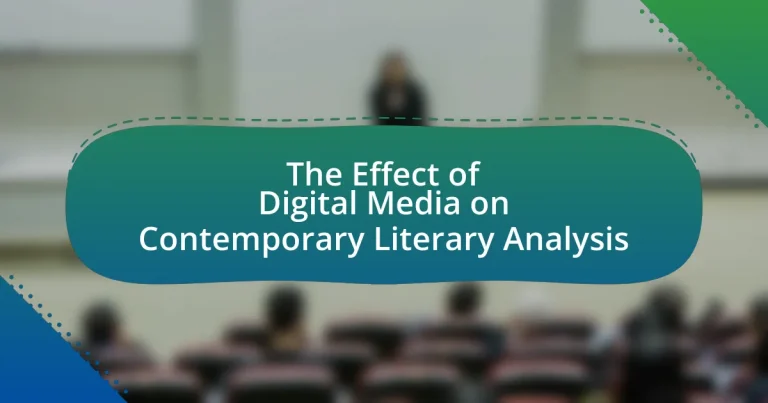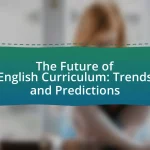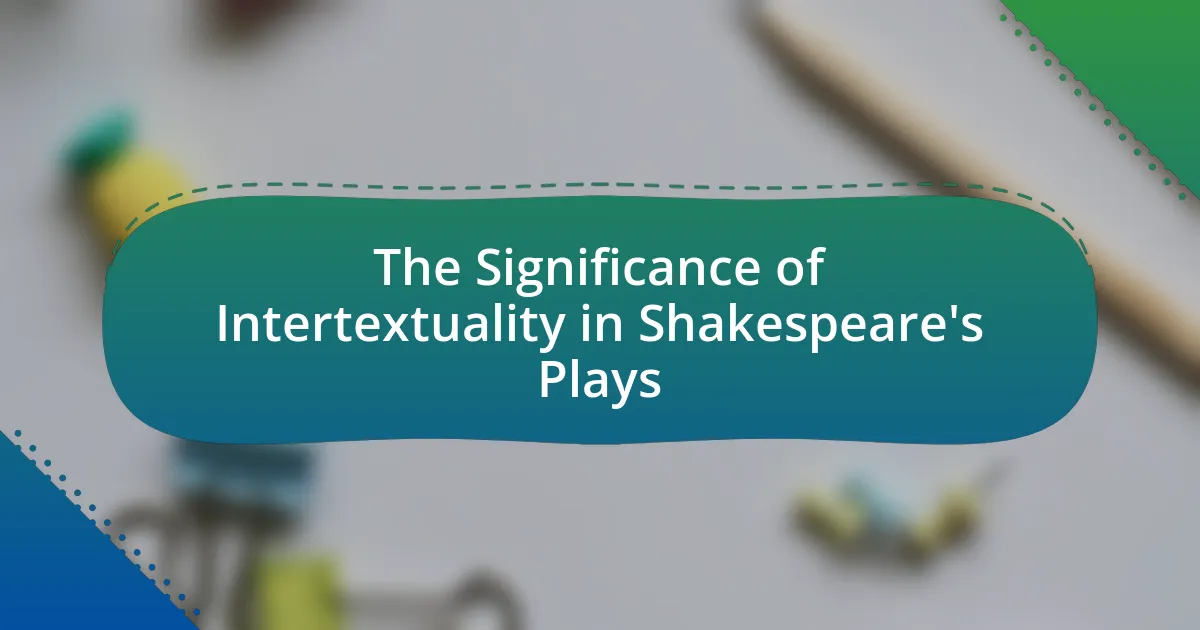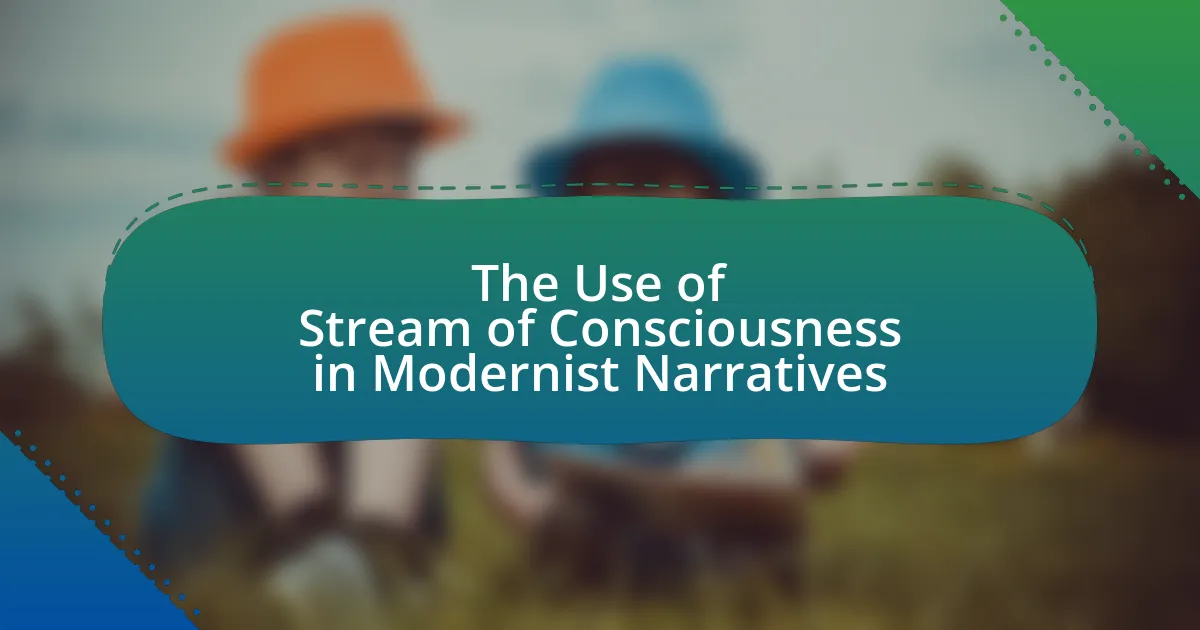The article examines the significant impact of digital media on contemporary literary analysis, highlighting how it transforms text accessibility, interpretation, and critique. It discusses the shift from traditional methods, which rely on close reading and established critical theories, to digital approaches that utilize computational tools like text mining and data visualization. Key differences between traditional and digital literary analysis are outlined, including the democratization of literature access and the emergence of new analytical methodologies. The article also addresses the challenges scholars face in adapting to digital media, the implications for reader engagement, and best practices for integrating digital tools into literary studies.
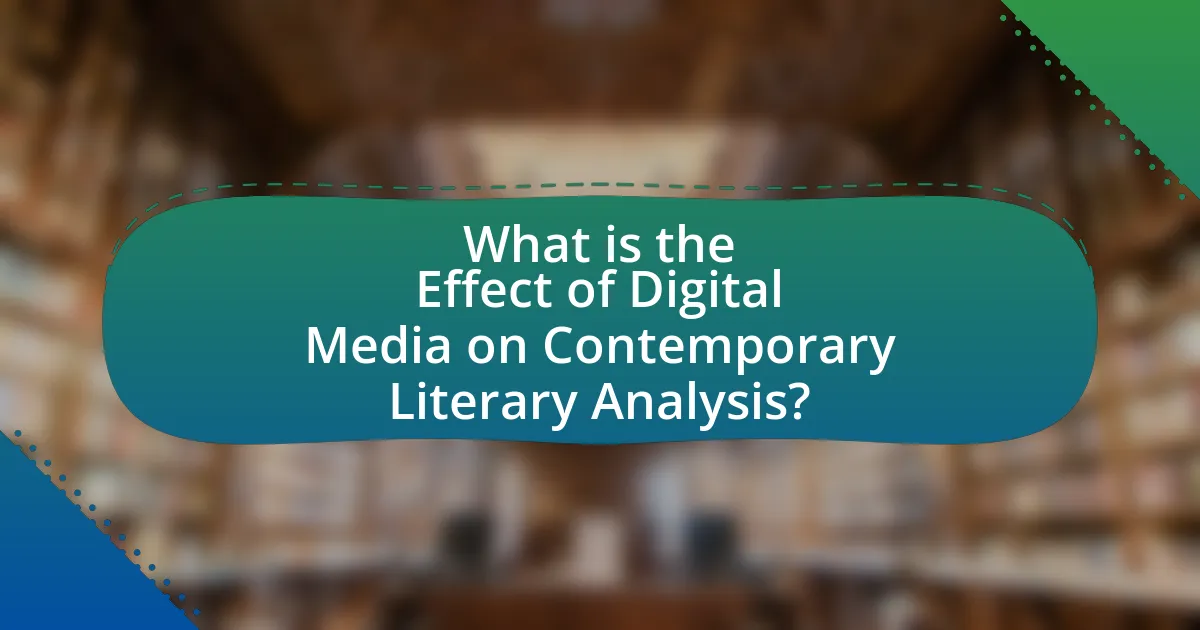
What is the Effect of Digital Media on Contemporary Literary Analysis?
Digital media significantly influences contemporary literary analysis by transforming how texts are accessed, interpreted, and critiqued. The rise of digital platforms allows for immediate access to a vast array of literary works, enabling scholars and readers to engage with texts in diverse formats, such as e-books, audiobooks, and online articles. This accessibility fosters a more inclusive literary discourse, as it democratizes access to literature and critical resources. Furthermore, digital media facilitates new analytical methods, such as data mining and text analysis, which enable researchers to uncover patterns and trends across large corpuses of text. Studies, such as those published in the “Digital Scholarship in the Humanities,” demonstrate that these methods can yield insights that traditional analysis might overlook, thereby enriching the field of literary studies.
How has digital media transformed traditional literary analysis?
Digital media has transformed traditional literary analysis by enabling new methods of text interaction and interpretation. The integration of digital tools allows for quantitative analysis, such as text mining and data visualization, which can uncover patterns and trends in literature that were previously difficult to identify. For instance, projects like the Digital Literary Studies initiative have demonstrated how algorithms can analyze large corpuses of texts, revealing insights about language usage and thematic development across different periods. Additionally, digital platforms facilitate collaborative analysis, allowing scholars to share findings and engage in discussions in real-time, thus broadening the scope and depth of literary critique.
What are the key differences between traditional and digital literary analysis?
Traditional literary analysis primarily relies on close reading and interpretation of texts through established critical theories, while digital literary analysis utilizes computational tools and methods to analyze large datasets of texts. Traditional analysis often emphasizes subjective interpretation and historical context, whereas digital analysis focuses on quantitative data, patterns, and trends across multiple texts. For instance, digital tools can process vast amounts of literature quickly, enabling researchers to identify linguistic patterns or thematic elements that may not be apparent through traditional methods. This shift allows for a broader scope of analysis, as evidenced by projects like the “Digital Literary Studies” initiative, which showcases how digital methods can enhance understanding of literary trends over time.
How do digital platforms influence the interpretation of texts?
Digital platforms significantly influence the interpretation of texts by altering accessibility, context, and reader engagement. These platforms enable a wider audience to access diverse texts, which can lead to varied interpretations based on individual backgrounds and experiences. For instance, social media allows for real-time discussions and feedback, shaping how texts are understood and critiqued. Research by the Pew Research Center indicates that 72% of adults use social media, which facilitates the sharing of interpretations and perspectives that can challenge traditional literary analysis. Additionally, digital annotations and hypertextual links provide contextual information that can shift a reader’s understanding of a text, demonstrating how the medium can affect meaning.
Why is understanding the effect of digital media important for literary scholars?
Understanding the effect of digital media is crucial for literary scholars because it fundamentally alters how texts are produced, disseminated, and consumed. Digital media platforms enable new forms of storytelling and reader engagement, which can reshape literary analysis and interpretation. For instance, the rise of e-books and online literature has expanded access to diverse voices and genres, challenging traditional literary canons. Additionally, digital media facilitates the study of reader interactions and community formations around texts, as evidenced by the popularity of fan fiction and online literary discussions. This shift necessitates that scholars adapt their methodologies to account for these changes, ensuring that their analyses remain relevant in a rapidly evolving literary landscape.
What challenges do scholars face in adapting to digital media?
Scholars face several challenges in adapting to digital media, including issues related to digital literacy, the preservation of academic integrity, and the rapid pace of technological change. Digital literacy is essential for effectively navigating and utilizing digital tools, yet many scholars lack the necessary skills, which can hinder their research and teaching. Additionally, the ease of access to information online raises concerns about plagiarism and the authenticity of sources, making it crucial for scholars to maintain academic integrity. Furthermore, the fast-evolving nature of digital media means that scholars must continuously update their knowledge and skills to keep pace with new platforms and technologies, which can be resource-intensive and time-consuming. These challenges highlight the complexities scholars encounter as they integrate digital media into their work.
How does digital media expand the accessibility of literary works?
Digital media expands the accessibility of literary works by providing platforms that allow for widespread distribution and availability of texts. E-books, online libraries, and literary websites enable readers to access a vast array of literature from anywhere in the world, often at little to no cost. For instance, platforms like Project Gutenberg offer over 60,000 free eBooks, making classic literature readily available to anyone with internet access. Additionally, digital media facilitates the inclusion of diverse voices and genres that may not have been represented in traditional publishing, thus broadening the scope of literary works accessible to a global audience.
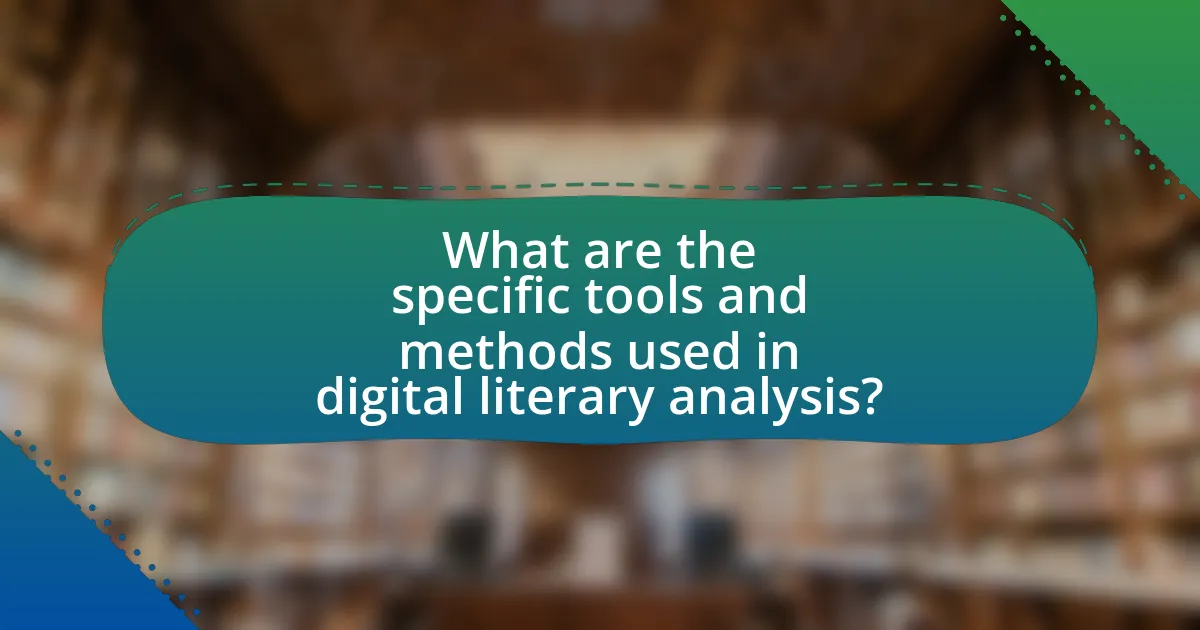
What are the specific tools and methods used in digital literary analysis?
Digital literary analysis employs specific tools and methods such as text mining, data visualization, and computational linguistics. Text mining allows researchers to extract meaningful patterns and insights from large corpora of literary texts, utilizing software like Voyant Tools and AntConc. Data visualization techniques, often implemented through tools like Gephi and Tableau, help in representing complex data relationships visually, making it easier to interpret literary trends and connections. Computational linguistics methods, including natural language processing algorithms, enable the analysis of linguistic features and stylistic elements across texts, facilitating deeper understanding of authorship and genre. These tools and methods collectively enhance the analytical capabilities of scholars in the field of digital literary studies.
How do digital tools enhance textual analysis?
Digital tools enhance textual analysis by enabling the processing of large volumes of text quickly and efficiently. These tools, such as text mining software and natural language processing algorithms, allow researchers to identify patterns, themes, and sentiments within texts that would be difficult to discern manually. For instance, a study by Jockers and Mimno (2013) demonstrated that computational methods could reveal stylistic differences across literary genres, providing insights into authorial voice and historical context. This capability to analyze extensive datasets not only accelerates research but also opens new avenues for understanding literature through quantitative metrics.
What are the most popular digital tools for literary analysis?
The most popular digital tools for literary analysis include Voyant Tools, AntConc, and Literary Analysis Software. Voyant Tools is a web-based application that allows users to visualize and analyze texts through various data visualization techniques, making it widely used in digital humanities. AntConc is a corpus analysis tool that enables researchers to conduct textual analysis and linguistic research, particularly useful for examining large datasets. Literary Analysis Software, such as NVivo, provides qualitative data analysis capabilities, allowing for in-depth examination of themes and patterns in literary texts. These tools are favored for their ability to handle large volumes of text and provide insights that traditional methods may overlook.
How do these tools facilitate new forms of interpretation?
Digital media tools facilitate new forms of interpretation by enabling interactive engagement with texts, allowing for multi-dimensional analysis and diverse perspectives. These tools, such as digital annotation platforms and text analysis software, provide features that support collaborative interpretation, visualizations of data, and access to a wide range of supplementary materials. For instance, platforms like Voyant Tools allow users to visualize text data through word clouds and frequency graphs, which can reveal patterns and themes not easily discernible in traditional formats. This capability enhances critical thinking and encourages readers to explore texts in innovative ways, ultimately transforming literary analysis into a more dynamic and participatory process.
What methodologies are emerging in the field of digital literary studies?
Emerging methodologies in the field of digital literary studies include computational text analysis, digital mapping, and network analysis. Computational text analysis utilizes algorithms to examine large corpora of texts, enabling scholars to identify patterns and trends that would be difficult to discern through traditional close reading. Digital mapping allows researchers to visualize geographical and historical contexts of literary works, enhancing the understanding of spatial relationships in narratives. Network analysis examines the relationships between characters, themes, and texts, providing insights into the interconnectedness of literary elements. These methodologies are increasingly adopted in academic research, as evidenced by studies published in journals such as “Digital Scholarship in the Humanities,” which highlight their effectiveness in expanding literary analysis beyond conventional methods.
How does computational analysis contribute to literary studies?
Computational analysis significantly enhances literary studies by enabling the examination of large text corpora through quantitative methods. This approach allows scholars to identify patterns, trends, and relationships within texts that would be difficult to discern through traditional qualitative analysis alone. For instance, techniques such as text mining and sentiment analysis can reveal underlying themes and emotional tones across multiple works, providing insights into literary movements and authorial intent. Studies, such as those conducted by Franco Moretti in “Graphs, Maps, Trees: Abstract Models for Literary History,” demonstrate how computational methods can map literary history and influence, showcasing the impact of digital tools on understanding literature’s evolution.
What role does data visualization play in understanding literature?
Data visualization plays a crucial role in understanding literature by transforming complex textual data into accessible visual formats, enabling clearer insights and patterns. For instance, visualizations such as word clouds, sentiment graphs, and thematic maps allow scholars to quickly identify trends, themes, and emotional tones within large bodies of text. Research by Franco Moretti in “Graphs, Maps, Trees: Abstract Models for Literary History” illustrates how visual tools can reveal structural relationships and historical contexts that may not be immediately apparent through traditional reading methods. This approach enhances literary analysis by providing a multi-dimensional perspective on texts, facilitating deeper comprehension and engagement with literary works.
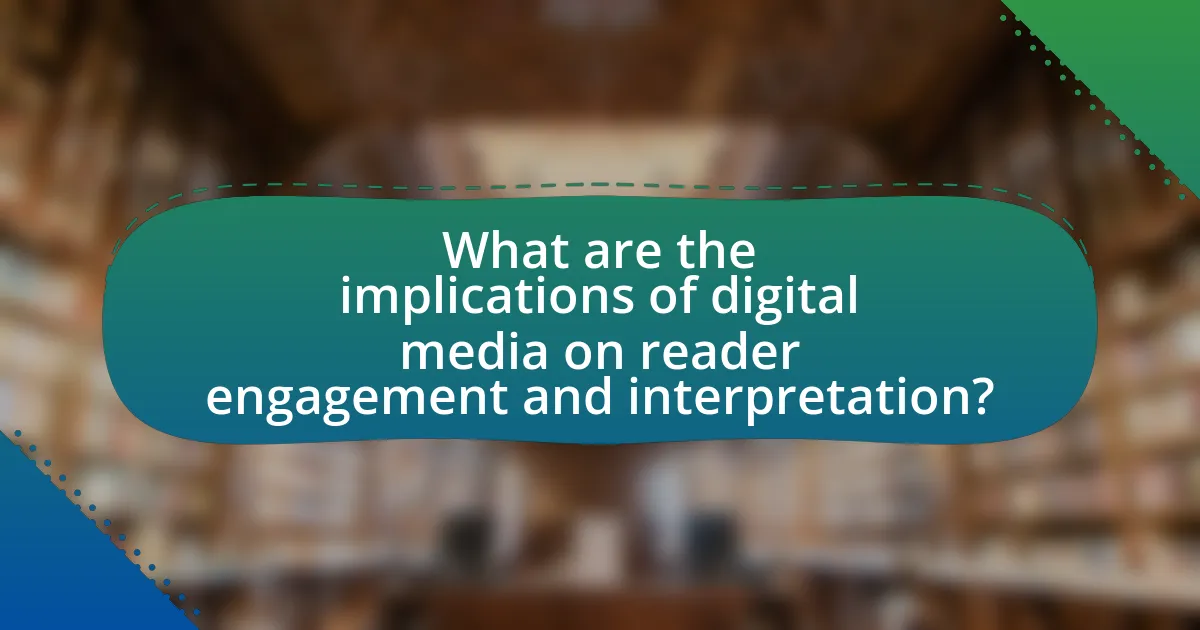
What are the implications of digital media on reader engagement and interpretation?
Digital media significantly enhances reader engagement and alters interpretation by providing interactive and multimodal experiences. Readers can access diverse formats such as videos, podcasts, and interactive texts, which cater to various learning styles and preferences, thereby increasing engagement levels. Research indicates that interactive elements, such as hyperlinks and multimedia content, can lead to deeper cognitive processing, as evidenced by a study published in the Journal of Educational Psychology, which found that students who engaged with interactive digital content demonstrated improved comprehension and retention compared to those who read traditional texts. Furthermore, digital media allows for real-time feedback and community interaction, fostering collaborative interpretation and discussion among readers, which can lead to a richer understanding of the text.
How does digital media change the way readers interact with texts?
Digital media transforms reader interaction with texts by enabling non-linear navigation and immediate access to supplementary content. Readers can engage with hyperlinked materials, multimedia elements, and interactive features, which enhance comprehension and retention. Research indicates that 70% of readers prefer digital formats for their ability to incorporate multimedia, according to a study by Pew Research Center. This shift allows for a more immersive experience, as readers can explore related topics and engage in discussions through social media platforms, fundamentally altering traditional reading practices.
What impact does social media have on literary discussions?
Social media significantly enhances literary discussions by facilitating immediate and widespread engagement among readers and writers. Platforms like Twitter and Goodreads allow users to share opinions, critiques, and recommendations in real-time, fostering a dynamic dialogue around literary works. Research indicates that social media can increase the visibility of diverse voices in literature, as evidenced by the rise of book-related hashtags and online book clubs that promote underrepresented authors. Additionally, a study by the Pew Research Center found that 72% of adults use social media, creating a vast audience for literary discourse and enabling discussions that transcend geographical boundaries.
How do online communities influence literary interpretation?
Online communities significantly influence literary interpretation by facilitating diverse discussions and interpretations among readers. These platforms allow individuals to share personal insights, cultural contexts, and analytical perspectives, which can reshape collective understanding of texts. For instance, forums and social media groups often highlight varying interpretations based on regional or cultural backgrounds, leading to a richer, multifaceted analysis of literature. Research indicates that participation in online literary discussions can enhance critical thinking and analytical skills, as users engage with contrasting viewpoints and textual analyses. This collaborative environment fosters a dynamic exchange of ideas, ultimately broadening the scope of literary interpretation beyond traditional academic boundaries.
What are the potential drawbacks of digital media in literary analysis?
Digital media in literary analysis can lead to several potential drawbacks, including the oversimplification of complex texts and the risk of misinterpretation. The reliance on digital tools may encourage superficial engagement with literature, as readers might prioritize speed and convenience over deep analysis. Additionally, digital platforms can create echo chambers, where diverse interpretations are overshadowed by popular opinions, limiting critical discourse. Research indicates that the abundance of easily accessible information can overwhelm users, leading to cognitive overload and diminished comprehension. These factors collectively hinder the depth and quality of literary analysis in a digital context.
How can digital distractions affect deep reading practices?
Digital distractions significantly hinder deep reading practices by fragmenting attention and reducing comprehension. Research indicates that frequent interruptions from notifications and multitasking lead to shallow processing of information, making it difficult for individuals to engage with complex texts. A study by Rosen et al. (2013) found that students who frequently checked their devices while reading performed worse on comprehension tests compared to those who focused solely on the material. This decline in focus and retention illustrates how digital distractions can undermine the ability to engage deeply with literature, ultimately affecting critical analysis and interpretation skills.
What are the risks of oversimplification in digital analysis?
The risks of oversimplification in digital analysis include the potential for misinterpretation of data, loss of nuanced insights, and the overlooking of critical contextual factors. When digital analysis reduces complex literary works to mere quantitative metrics, it can lead to erroneous conclusions about themes, character development, and authorial intent. For instance, a study by Jockers and Mimno (2013) demonstrated that relying solely on word frequency can obscure deeper narrative structures and stylistic elements, ultimately diminishing the richness of literary interpretation. This highlights how oversimplification can compromise the integrity of analysis and lead to a superficial understanding of texts.
What best practices should scholars adopt when integrating digital media into literary analysis?
Scholars should adopt a multi-modal approach when integrating digital media into literary analysis, which involves utilizing various digital tools and platforms to enhance textual interpretation. This approach allows for the incorporation of visual, auditory, and interactive elements that can deepen understanding and engagement with literary texts. For instance, using digital mapping tools can help visualize geographical contexts in literature, while multimedia presentations can illustrate thematic connections through video and audio clips. Research indicates that such integration not only enriches analysis but also caters to diverse learning styles, making literary studies more accessible and engaging for a broader audience.
How can scholars balance traditional and digital methods effectively?
Scholars can balance traditional and digital methods effectively by integrating both approaches in their research processes. This integration allows for a comprehensive analysis that leverages the strengths of each method; traditional methods provide depth and context, while digital methods offer efficiency and access to vast datasets. For instance, a study published in “Literary Studies in the Digital Age” by Andrew Piper highlights how scholars can use digital tools to analyze large corpuses of text while still employing traditional close reading techniques to interpret nuanced meanings. This dual approach not only enriches literary analysis but also fosters a more holistic understanding of texts in the digital age.
What strategies can enhance the quality of digital literary analysis?
Incorporating interdisciplinary approaches enhances the quality of digital literary analysis. By integrating methodologies from fields such as computer science, linguistics, and cultural studies, analysts can leverage diverse perspectives and tools. For instance, using natural language processing (NLP) techniques allows for the quantitative analysis of text patterns, while cultural context enriches qualitative interpretations. Studies have shown that combining these methods leads to more nuanced insights, as evidenced by research from the Digital Humanities community, which emphasizes the importance of collaboration across disciplines to deepen understanding of literary texts in a digital context.
